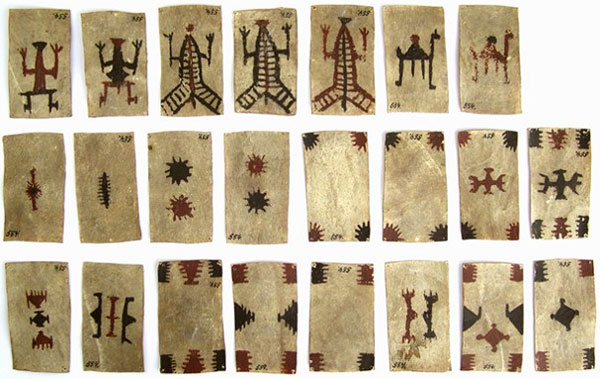Ethnographic playing cards made by members of the Aónikenk culture, an Indigenous people of Patagonia, from two similar, partial packs, decorated with geometric, zoomorphic or anthropomorphic motifs of expressive power, using red and black pigments bound with oil to lend durability.
Collected between 1853 and 1865, these playing cards are a clear example of the cultural influence experienced by the Aónikenk people as a result of conquest and immigration. The designs seem to follow a Spanish-suited format, probably 40 cards, which have been imitated and stylized by the indigenous people. Like Apaches, Arancaunian groups played their own gambling games prior to the arrival of the Spaniards, but Spanish cards and games were avidly accepted (Wayland & Ferg 2006). Consequently rawhide cards were made. This object beautifully illustrates how external forces shaped their traditions and artistic expressions.

Above: hand-painted Aonikenk playing cards probably painted using iron oxide and charcoal, collected by Governor Jorge Schythe during his stay in Magallanes between 1853 and 1865. From the National Museum of Natural History of Chile / Centro de Documentación de Bienes Patrimoniales, Recoleta 683, Recoleta, Santiago, Chile.
Acknowledgements & References
Thanks to Juan José Fernández Quiroga for kindly sending information about these cards and their whereabouts.
Centro de Documentación de Bienes Patrimoniales : 1-1240 – Baraja Aonikenk • 1-1195 – Baraja Aonikenk►
Wayland, Harold & Virginia, Ferg, Alan: Playing Cards of the Apaches, a study in cultural adaptation, Screenfold Press, 2006, pp.274-6. A complete 40-card set of Araucanian rawhide cards from the Museo de Ciencias Naturales de La Plata, Argentina, is illustrated on page 276.

The cards have highly modified and abstracted Spanish suit symbols with sota, caballo and rey figures, and may have been made to sell or for personal use. The designs also resemble decorative patterns seen on other folk-art items like blankets, which are often symbolic, rooted in cosmology, spiritual life and cultural identity. The figures resemble guanacos and perhaps shamans, dancers or spirit figures.